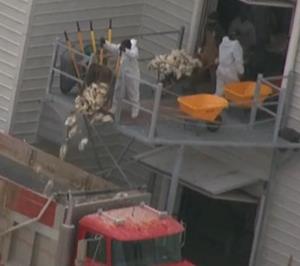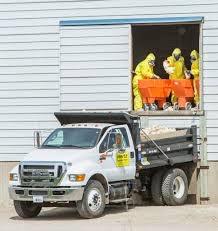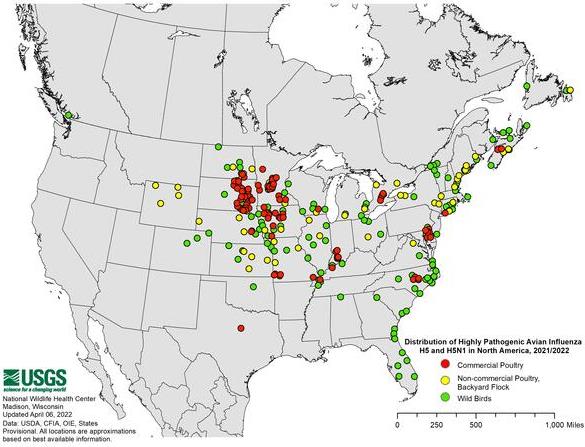During the past eight weeks, nine noteworthy outbreaks of highly pathogenic Avian Influenza (HPAI) in egg-production complexes have been documented resulting in depletion of more than 21 million hens in addition to close to a million pullets. It is understood that, as with the 2015 epornitic,  epidemiological questionnaires were completed after each outbreak. A review of these documents with or without case control studies could indicate deficiencies in biosecurity that contributed to the introduction of infection onto complexes requiring subsequent depletion.
epidemiological questionnaires were completed after each outbreak. A review of these documents with or without case control studies could indicate deficiencies in biosecurity that contributed to the introduction of infection onto complexes requiring subsequent depletion.
Approximately twelve million hens ago, this commentator communicated with a senior APHIS Veterinarian responsible for aspects of control of HPAI. In the absence of a response, a second E-mail was addressed to the APHIS contact urging action with respect to providing guidance derived from a review of the questionnaires. Despite webinars and regular updates, APHIS has not provided any specifics as to the risk factors contributing to infection with the H5N1 strain expressing Eurasian genes that is prevalent in 2022.
It is accepted that the widespread distribution of the virus is due to dissemination by migratory waterfowl. This is confirmed by surveillance and the large number of turkey growing units and backyard flocks affected in the same states where outbreaks have occurred on egg production complexes. This presumes that most egg farms if present in affected states are at risk of exposure. At this time, it is critical to know what factors were associated with the relatively limited number of outbreaks that have occurred despite the probability of exposure. If a preliminary evaluation discloses a common factor or deviations from accepted standards of structural and operational biosecurity, this information would be valuable to producers that have not been affected.
 If some specific defect or combination of deficiencies in either structural or operational biosecurity could be identified and publicized, it would benefit all producers who face exposure to HPAI. Obtaining provisional information in real time may prevent additional outbreaks obviating costs to the public and private sectors. While it is recognized that from a scientific perspective a detailed case-controlled study would be ideal and will be conducted, a considered opinion now, based on experience and insight as to possible deficiencies in biosecurity or causal factors would be highly beneficial to prevention. Recommendations from a preliminary evaluation may motivate remedial action and would allay concerns relating to potential outbreaks.
If some specific defect or combination of deficiencies in either structural or operational biosecurity could be identified and publicized, it would benefit all producers who face exposure to HPAI. Obtaining provisional information in real time may prevent additional outbreaks obviating costs to the public and private sectors. While it is recognized that from a scientific perspective a detailed case-controlled study would be ideal and will be conducted, a considered opinion now, based on experience and insight as to possible deficiencies in biosecurity or causal factors would be highly beneficial to prevention. Recommendations from a preliminary evaluation may motivate remedial action and would allay concerns relating to potential outbreaks.
A preliminary opinion based on the review of the questionnaires relating to nine major outbreaks could be provided by APHIS with the understanding that a detailed study will be conducted after resolution of the present epornitic. A preliminary report in late April would be far more beneficial than a comprehensive document in 2023 or later. Given previous requests to APHIS, a provisional report would have had more impact when requested in late March.
APHIS has access to the required data and their epidemiologists with field training could rapidly review the questionnaires for possible factors contributing to outbreaks. If APHIS is either disinclined to conduct an initial review or is overwhelmed, then it is respectfully suggested that coded questionnaires be provided to a competent team comprising poultry health professionals in academia and industry. Their review and comment could provide unaffected producers with observations and recommendations to reinforce biosecurity and to correct any obvious defects arising from the questionnaires and follow-up.

There are immense direct and indirect costs arising from an outbreak of HPAI on a large egg-production complex. Expenses accruing to the public and private sectors include flock depopulation, disposal and decontamination, surveillance, disruption of ongoing production, loss of revenue and goodwill and widespread impacts on individuals and communities. The inflexibility of APHIS with respect to conducting a much-needed evaluation of the epidemiological questionnaires is incomprehensible. Preventing even one outbreak on a one-million bird complex would provide an infinite return on the time devoted to a review as compared to the cost of depletion, disposal loss of revenue and ultimately added cost to consumers.